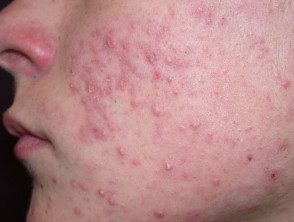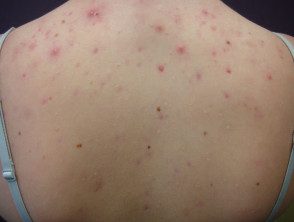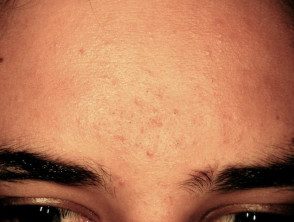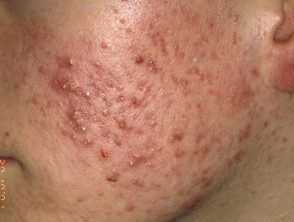Most people with blemishes have a medical condition called acne vulgaris. Vulgaris is the medical term for "common." It is given this name to distinguish it from the less common variants of acne (see all types of acne).
You may prefer to call acne "pimples," "blemishes," or "pimples."
Who gets acne vulgaris?
Almost everyone has acne at some point or another. It mostly affects teenagers (and can start as early as age 8), but acne can persist, start, or become more severe in adulthood.
Learn more about the causes of acne ...
What are the clinical features of acne vulgaris?
Acne most often affects the face, but can spread to involve the neck, chest, and back, and sometimes even more extensively on the body.
Individual lesions focus on the pilosebaceous unit, that is, the hair follicle and its associated sebaceous gland. There are several types of acne blemishes, often at the same time. They may be inflamed papules, pustules and nodules; or not inflamed comedones and pseudocysts.
Superficial injuries
- Open and closed comedones (blackheads and whiteheads)
- Papules (small, tender red bumps)
- Pustules (white or yellow “squeeze” spots)
Deeper injuries
- Nodules (large, painful red bumps)
- Pseudocysts (cyst-I like it fluctuating swellings)
Secondary injuries
- Excoriations (points chosen or scratched)
- Erythematous macules (red markings from recently healed spots, best seen on fair skin)
- Pigmented macules (dark marks from old spots, mainly affecting people with dark skin)
-
Scars or various types
Individual acne lesions generally last less than 2 weeks, but deeper papules and nodules can persist for months. Many acne patients also have oily skin (seborrhea).
Common acne

Common acne

Common acne

Common acne
More acne images ...
- Facial acne
- Back acne
Acne classification
Acne can be classified as mild, moderate, or severe. Comedones and inflammatory Injuries are generally considered separately.
Mild acne
- <20 comedones
- <15 lesiones inflamatorias
- Or total injury tell <30
Moderate acne
- 20–100 comedones
- 15-50 inflammatory lesions
- Or, total lesion count 30–125
Severe acne
- > 5 pseudocysts
- Total comedo count> 100
- Total inflammatory count> 50
- Or total lesion count> 125
Classification of acne.

Mild acne

Moderate acne

Severe acne
Some dermatologists assess the severity of a patient's acne more accurately using a classification. scale. Inflammatory lesions are compared to a standard set of photographs to determine the grade, which can range from 1 (very mild) to 12 (exceptionally severe), for example.
In clinical trials evaluating acne treatment, the number of non-inflamed and inflamed lesions is carefully counted at regular intervals. It is remarkably difficult to count constantly.
What is the treatment for acne vulgaris?
Treatment for acne depends on the age of the patient and sex, the extent and severity of acne, how long it has been present, and the response to previous treatments.
- Treatment for mild acne includes current anti-acne preparations, lasers and lights
- Treatment for moderate acne adds antibiotics for acne like tetracyclines and / or antiandrogens like birth control pill
- Treatment for severe acne may require a course of oral isotretinoin.

